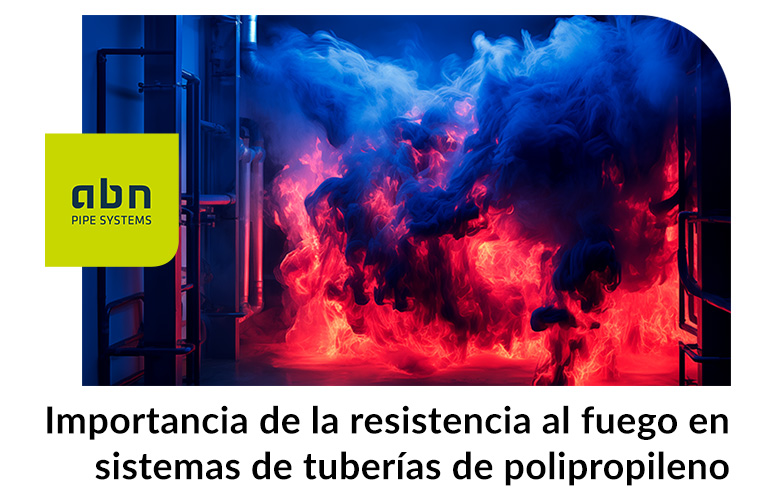En el mundo de la ingeniería y la construcción, la seguridad es una prioridad. La evaluación de la resistencia al fuego de los materiales de construcción es una parte esencial de la planificación y edificación de estructuras seguras.
Desde la selección de la tipología de los materiales hasta las pruebas de resistencia al fuego, cada aspecto contribuye a la creación de entornos más seguros y resistentes al fuego.
¿Cómo se clasifica la resistencia al fuego de un elemento constructivo?
El bienestar estructural de los edificios depende en gran medida de la capacidad de los sistemas de tuberías para mantener su funcionalidad incluso en las condiciones más extremas, como puede ser un incendio.
Para clasificar la reacción al fuego de los materiales de construcción, entre otros parámetros, se emplean de forma estandarizada las Euroclases. Esta clasificación se refiere a la unión realizada en 2004 de los criterios europeos de clasificación en la Reacción al Fuego de los materiales de construcción, la combustibilidad y otros parámetros como la emisión de humo y la caída de gotas inflamadas.
En España, en base al sistema anterior, se definió el Código Técnico de la Edificación (CTE) que establece las exigencias básicas de calidad que deben cumplir los edificios en relación con los requisitos básicos de seguridad y habitabilidad. En referencia a los sistemas de tuberías, destaca que en el caso de los elementos constructivos que se sitúen en pasillos y escaleras protegidos o en aparcamientos y recintos de riesgo especial, estos deben cumplir con una clasificación rigurosa de B-s1, d0. Lo significa, según las Euroclases, que el elemento debe estar fabricado con “materiales difícilmente combustibles” (B), con una “emisión de humo escasa” (s1) y que no produzca “ningún goteo” (d0).
Las tuberías de polipropileno y su reacción al fuego
En este contexto, las tuberías insonorizadas de polipropileno emergen como una solución innovadora y segura. La gama ABN//EVAC Energy Plus (tubería + accesorios) es un ejemplo de este tipo de tuberías, que no solo destacan por su capacidad para resistir el desgaste y la corrosión, sino que también presentan una resistencia excepcional al fuego.
Siguiendo la clasificación de reacción al fuego según la norma UNE EN 13501, esta gama está aditivada para superar las pruebas de reacción al fuego más exigentes, que le dan la Certificación AENOR constatando el cumplimiento de los requisitos de estas normas y el cumplimiento del Código Técnico de la Edificación (CTE). Además, esta gama también se ha sometido a ensayos como el de densidad óptica de humos o el de determinación de cantidad de gas halógeno en el producto del Instituto Gaiker.
Por otro lado, la maleabilidad del polipropileno permite una instalación rápida y sencilla, mediante junta elástica, sin necesidad de usar colas o pegamentos (como en el caso del PVC, lo que reduce los tiempos de construcción y los costes asociados). Esto se traduce en un beneficio adicional para proyectos que buscan no solo cumplir con los estándares de resistencia al fuego más exigentes sino también optimizar la eficiencia general del proyecto.
Pruebas de resistencia al fuego en tuberías
Un componente central en la evaluación de la resistencia al fuego en sistemas de tuberías son las pruebas de resistencia al fuego. Estas simulan condiciones de incendio real y testan cómo los sistemas de tuberías se comportan bajo diferentes niveles de temperatura y presión. Los resultados de estas pruebas son cruciales para determinar la clasificación de resistencia al fuego de un sistema específico.
Para llevar a cabo una evaluación precisa, es necesario seguir normativas y estándares internacionales reconocidos. Organizaciones como la ASTM (American Society for Testing and Materials), la ISO (International Organization for Standardization) y la NFPA (National Fire Protection Association) proporcionan directrices detalladas para las pruebas de resistencia al fuego. Estas normas aseguran que la evaluación se realice de manera rigurosa y estandarizada, proporcionando una base sólida para la toma de decisiones en el diseño y la instalación de sistemas de tuberías resistentes al fuego.
No obstante, la evaluación de la resistencia al fuego no debe limitarse a un evento único. El mantenimiento regular y las inspecciones continuas son esenciales para garantizar que los sistemas de tuberías sigan cumpliendo con los estándares de resistencia al fuego a lo largo del tiempo. La detección temprana de posibles problemas y una intervención anticipada pueden marcar la diferencia en la seguridad general del edificio.
